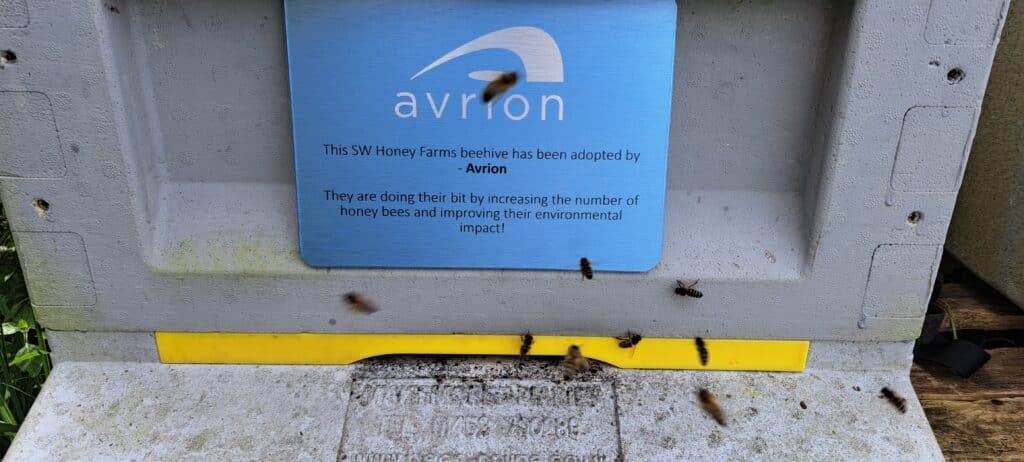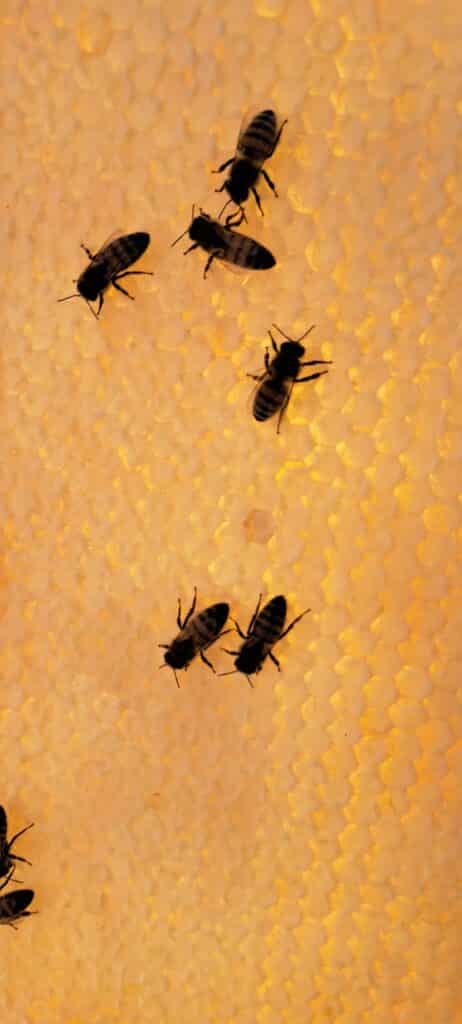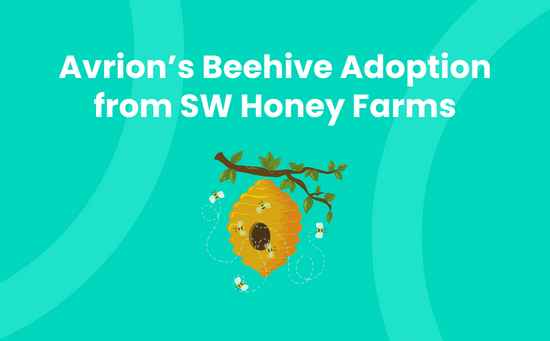At Avrion, we are dedicated to corporate social responsibility and ecological preservation. In June 2023, we took a significant step towards supporting the ecosystem with beehive adoption. We decided to adopt a beehive from SW Honey Farms, a beekeeping initiative led by Stuart Weekes.

Check out the bee photo-bombing the picture above, almost on the dot of the ‘i’ in our logo! Love it!
For this blog, we asked Stuart a few questions to find out more about SW Honey Farms, why bees are so important, beehive adoption, and some general interesting information about bees.
Who is Stuart Weekes?
My name is Stuart Weekes and I’m a beekeeper from West Sussex. I have been in the industry for around 8 years now and have enjoyed every second of it (even the bee stings!)
What inspired you to start SW Honey Farms?
I wanted to start SW Honey Farms to be able to grow in the industry on my own, and introduce others to the wonderful world of honeybees and showcase their importance to our ecosystem.
Why are bees important for pollination?
Bees play a vital role in pollination by transferring pollen from the male parts of a flower to the female parts, facilitating fertilisation and the production of fruits and seeds. This process is crucial for the reproduction of many plant species. Honeybees contribute to 1/3 of all food we eat.
How do bees contribute to the ecosystem and biodiversity?
Bees are important pollinators, facilitating the reproduction of flowering plants, including many crops and wildflowers. Their activities help maintain biodiversity, ensure food production, and support the functioning of ecosystems.
How are bees affected by climate change and habitat loss?
Climate change and habitat loss pose significant threats to bee populations. Changes in temperature, rainfall patterns, and the availability of flowers can disrupt their life cycles and foraging patterns. Habitat loss deprives bees of suitable nesting sites and reduces their food sources, leading to population declines.
Why should people/businesses consider beehive adoption?
Beehive adoption has a direct impact on the local area by introducing thousands of pollinating honey bees.
How many beehives do you have now, and how many have been adopted (if different)?
I currently have 82 beehives with 73 being adopted. They range in different styles from British national to 14×12 and Langstroth.

What have the Avrion bees been up to this month?
This month marks an important period of transition for your colony, as they prepare for the approaching winter. The foraging season winds down by October as the bees’ foraging activity starts to dwindle. They continue gathering any remaining nectar and pollen (usually the remaining ivy flowers), but there is a noticeable decrease in overall foraging efforts. I observed the emergence of what are commonly called “winter bees.” These bees have a longer lifespan and are better equipped to endure the winter.
As the nights become increasingly colder the bees will huddle together within the hive, forming a tight cluster. This behaviour is part of their strategy to maintain warmth and conserve energy. Guard bees are extremely vigilant during October, keeping a close watch on the hive entrance to ward off potential threats, such as wasps and sometimes myself.
The queen’s egg laying is significantly reduced in October, almost to the point of a full stop. The colony’s priority shifts from expansion to the survival of the existing bees, and to make it through the approaching winter. The bees also use propolis, a sticky resin collected from plants, to seal and insulate the hive. This action is vital for maintaining a stable environment inside, especially in anticipation of harsh winter conditions. They are housed in the most common hive type in the UK, called the British national hive. This hive is made out of polystyrene to increase the chances of survival over the winter with its thermal properties, and has been one of the best investments I have made.
Your bees have a large quantity of reserves for the coming winter and this picture shows a pulled frame showing the sun shining through a frame of honey. The breed of your bees are called “Buckfast” and are actually from the original line of Buckfast that was created by a man named brother Adam from Buckfast Abbey. He created this breed to be the best for honey production, calmness, dampened aggression and winter survival. This is why it is now one of the most widely used breeds in the UK.
What is your favourite type of bee and why?
My favourite type of bee must be the worker bee. They look after the hive and maintain the queen’s health, making sure she is fed and cleaned.
What is your favourite fact about bees?
My favourite fact has to be the waggle dance. When bees find a source that is beneficial for the hive, i.e. water, nectar, pollen – they then return to the hive and perform a waggle dance for the viewing bees. This dance tells the viewing bees the location and quality of the source within a three-mile radius of the hive! Amazing!
Further information on beehive adoption
If we have inspired you to ‘bee’ more responsible and you’re interested in beehive adoption, helping to improve the world one bee at a time, visit swhoneyfarms.com and mention Avrion.
- Tel: +44 (0)1992 661244
- Email: enquiries@avrion.co.uk
- Follow us on LinkedIn
- Subscribe to our YouTube channel
- Contact us here


